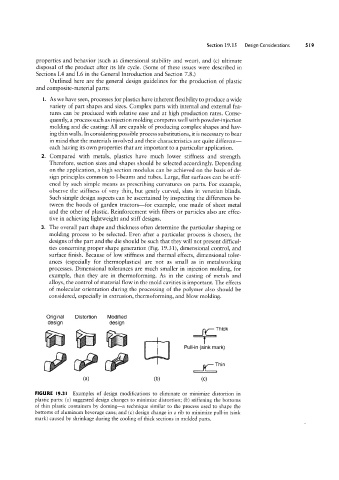Page 539 - 04. Subyek Engineering Materials - Manufacturing, Engineering and Technology SI 6th Edition - Serope Kalpakjian, Stephen Schmid (2009)
P. 539
Section 19.15 Design Considerations
properties and behavior (such as dimensional stability and wear), and (c) ultimate
disposal of the product after its life cycle. (Some of these issues were described in
Sections 1.4 and 1.6 in the General Introduction and Section 7.8.)
Outlined here are the general design guidelines for the production of plastic
and composite-material parts:
l. As we have seen, processes for plastics have inherent flexibility to produce a wide
variety of part shapes and sizes. Complex parts with internal and external fea-
tures can be produced with relative ease and at high production rates. Conse-
quently, a process such as injection molding competes well with powder-injection
molding and die casting: All are capable of producing complex shapes and hav-
ing thin walls. In considering possible process substitutions, it is necessary to bear
in mind that the materials involved and their characteristics are quite different-
each having its own properties that are important to a particular application.
2. Compared with metals, plastics have much lower stiffness and strength.
Therefore, section sizes and shapes should be selected accordingly. Depending
on the application, a high section modulus can be achieved on the basis of de-
sign principles common to I-beams and tubes. Large, flat surfaces can be stiff-
ened by such simple means as prescribing curvatures on parts. For example,
observe the stiffness of very thin, but gently curved, slats in venetian blinds.
Such simple design aspects can be ascertained by inspecting the differences be-
tween the hoods of garden tractors-for example, one made of sheet metal
and the other of plastic. Reinforcement with fibers or particles also are effec-
tive in achieving lightweight and stiff designs.
3. The overall part shape and thickness often determine the particular shaping or
molding process to be selected. Even after a particular process is chosen, the
designs of the part and the die should be such that they will not present difficul-
ties concerning proper shape generation (Fig. 1931), dimensional control, and
surface finish. Because of low stiffness and thermal effects, dimensional toler-
ances (especially for thermoplastics) are not as small as in metalworking
processes. Dimensional tolerances are much smaller in injection molding, for
example, than they are in thermoforming. As in the casting of metals and
alloys, the control of material flow in the mold cavities is important. The effects
of molecular orientation during the processing of the polymer also should be
considered, especially in extrusion, thermoforming, and blow molding.
Original Distortion Modified
design design Thick
Puii-in(smi<mari<)
dt;
(2) (b) (C)
FIGURE I9.3l Examples of design modifications to eliminate or minimize distortion in
plastic parts: (a) suggested design changes to minimize distortion; (b) stiffening the bottoms
of thin plastic containers by doming-a technique similar to the process used to shape the
bottoms of aluminum beverage cans; and (c) design change in a rib to minimize pull-in (sink
mark) caused by shrinkage during the cooling of thick sections in molded parts.

